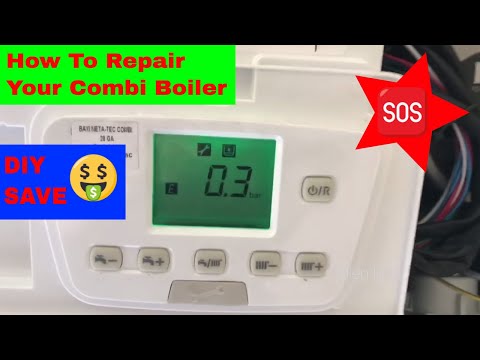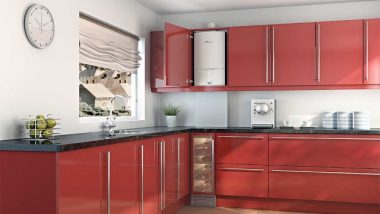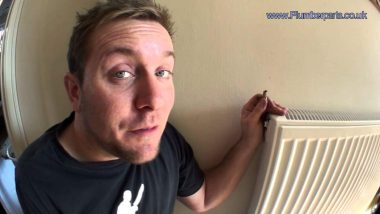Topping Up the Pressure on a Boiler is a simple task. We explain how to do it here in our Combi Boiler DIY Guide, which follows.
My name’s Allen Hart and today we’re going to show you how to how to re-pressurise and refill a Combi Boiler and central heating system.
First, take a look here. We can see here the front display is flashing. So, it’s got 0.3 and it’s got one 1/8.
That means low water pressure on this particular combi-boiler. In short, the water pressure in your boiler and central heating pipes/ radiators is too low.
It needs re-pressurizing!
This is a very easy DIY “repair” job.
Just to get your boiler back up and running and working again will only take a few moments.
Check for Any Leaks First
But, do check your house first for any radiator or pipe leaks. If you find any visible leak or wetness, you will have to call a plumber qualifies in boiler repairs.
We can see on the pressure gauge underneath the boiler here it is on zero.
That means we need to fill this up. We need to put some more water into the central heating system to make the boiler work again.
If we look underneath the boiler here, we’ve got two blue taps.
These taps are the taps that are the closest to the front of the boiler.
What we need to fill this up now. That means we want to put some water in, and we’re going to work on these valves to do that.
How to Top Up the Pressure on a Boiler
Now let’s get started with our beginner’s guide on “how to fill it up so how this works”.
Open the water valve for a few moments. That now allows water to go around and into the boiler pipes.
Gradually, the water pressure will rise as the additional water, at mains pressure enters the system.
It’s now showing 10 percent of the ideals pressure on the indicator panel or dial.
So, now we open that valve again and watch again and we will see the pressure start to go up again.
That’s what we want. But, one thing we do need to be careful is that we don’t put too much pressure in at once.
So we just back it off and reduce the flow a little bit and just do it slowly.
Then you’ll see the gauge will slowly go up.
if we put too much water in, this then that can cause more problems.
On this particular boiler, if it’s got too much pressure, it won’t work as well.
So, if we see on the gauge now on the bottom, as we’re putting cold water into this, the gauge is going up.
As I said, we need to be careful just not to put too much pressure in.
I would say that if you top up to just over 1, maybe in between 1 and 2, it will be good.
When you shut this valve off, it may drop down a little bit, and then when you look then at the front of the boiler after a minute or two, it will start working again.
I’ve just shut both of the taps off now, and when we go to the front of the boiler, it’s no longer flashing.
So now your boiler will be back working.
If you have a gas boiler always remember to call a Gas Safe Registered technician/ engineer out and never an unregistered guy.
We recommend an annual service on your boiler is best.
Thanks for reading this and we hope we have helped you.
As found on Youtube
What to do if the Pressure Goes Too High
If there is too much pressure, reduce it below the red area indicated on your pressure sensor. Do that by turning the release knob on your nearest radiator.
In other words, if while doing this you see the arm on the pressure gauge go into the red, you’ll need to release pressure from the system.
Using a wrench or protective mitts, turn the release knob (next to the release valve) on the radiator.
Make sure you’re standing clear of the release valve, though, as it will release hot pressurized water or air. via www.wikihow.com
Conclusion
One of the most common causes of broken boilers is the loss of water pressure. Low water pressure can be caused by several different things such as a leaking boiler. It is also possible to lose pressure when you bleed the radiators.
Low water pressure is easy to diagnose. Most modern boiler models feature a built- in pressure gauge that will show the boiler pressure. Before you start the steps to re-pressurize a boiler, first make sure that it indeed needs to be pressurized by checking the pressure gauge. This is usually found in front of the boiler.
Generally, the ideal water pressure should be between 1 and 2 bars. Some models will show a red bar where the water pressure was initially set.
A number of things can cause pressure to drop. It may be that there is a leak somewhere in your boiler system. Or, if you bled your radiators recently, it may be that pressure was lost then.
However, you may not be able to tell that you have a problem until you check the pressure gauge. A water leak, for instance, may be tiny and go unnoticed at first, only to develop into a larger problem down the line. via www.bristolreslet.com
If the water pressure is incorrect, you may be able to re-pressurize a boiler by yourself. Knowing how to increase boiler pressure properly can save you a visit from your local engineer. via rjgasheating.co.uk
A Gas Safe Registered Engineer spends 5 years studying, and hit their true level of experience in 5-10 years. Flue Gas Analysers are required by law, which cost between £600 & £1000. Flues Gas Analysers need to be calibrated annually and hold a certificate. Suitability of the boiler for the property needs to be checked.





How To Maintain Your House Heating Boiler
HTP’s house heating boilers present final consolation and the very best
overall efficiency ratings whereas holding maintenance and working costs to a minimum.
In dwell steam fashions , copper or brass is commonly used as a result of it’s extra simply fabricated in smaller size
boilers. Fireplace-tube boiler with Water-tube firebox.
Although such heaters are normally termed “boilers” in some international locations, their purpose is normally to supply sizzling water, not steam, and so they run at low pressure and attempt
to avoid boiling.
You always lose pressure when you bleed the radiators. a lot of people don’t realise that fact and wonder why their boiler stops heating after doing a rad bleed. Nice article.
The introduction of off-peak electric total management electric central heating was a big thing in the 1970s if you remember. The irony is that with the development of renewable power, those storage radiators and off-peak electric rates may be on the way back as the next big idea!
Superior Buyer Service: Our purpose is your complete
satisfaction with all features of your boiler and radiant heating system.
This reveals a significant enchancment within the efficiency of newer boiler techniques,
which is about 35 percent extra efficient than older ones.